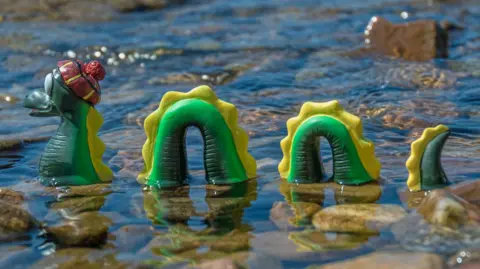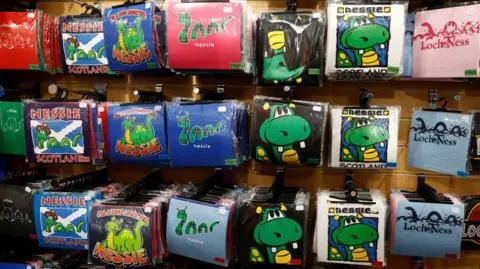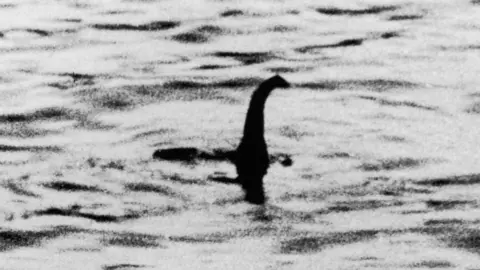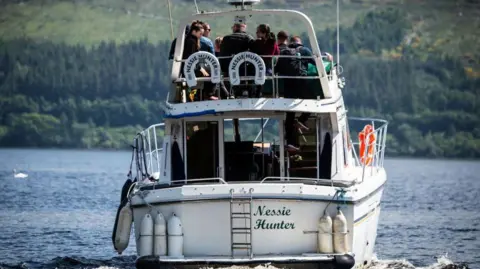Nessie's famous humps rarely seen by spotters, experts say
 Getty Images
Getty ImagesThe image of Nessie as a long, thin, three-humped monster has featured in Scottish culture for years.
Loch Ness Monster memorabilia in Highland gift shops and children's books depict a snakelike aquatic monster above the surface of the water with distinct hoops.
But new research has found the sea monster's undulating physique rarely features in reports by those who claim to have spotted her.
Researchers revealed only 1.5% of people who have claimed to see Nessie over the past 100 years have reported hoops or humps in their description.
The research by Dr Charles Paxton from the University of St Andrews and Adrian Shine of the Loch Ness Centre looked at the history of hooped sea monster imagery and its cultural prevalence.
They examined how often the imagery of Nessie's arched body appeared in postcards and said that between 25% and 32% showed her with visible humps trailing behind her head and neck.
They also showed the creature with a clear distance between her body and the surface of the water, which researchers said was "biologically impossible".
To start with, they said, the swimming method would be very inefficient, so the chances of her looking like that at the surface would be unlikely.
 Getty Images
Getty ImagesThe findings go against previous studies that suggest eyewitnesses are usually influenced by popular portrayals of mythical creatures they see in the media.
According to the research, the majority of sighting reports are actually based on some underlying physical reality.
"Scholars often assume that monsters are generated by cultural expectations, but it is always useful to test obvious hypotheses," Dr Paxton said.
"In this case it really seems witnesses do not generally report the impossible, even though the hooped monster is a common portrayal of Nessie."
How many times has Nessie been spotted?
 Getty Images
Getty ImagesTales of a monster date back to the Middles Ages when Irish monk St Columba is said to have encountered a creature in the Ness, a river that flows from Loch Ness.
But the first modern sighting - which has continued to capture public imagination ever since - was more than 90 years ago.
In April 1933, hotel manageress Aldie Mackay reported seeing a whale-like creature "churning" in the loch while she was on a car ride around the water.
The Inverness Courier newspaper reported the sighting and the editor at the time, Evan Barron, suggested the beast be described as a "monster".
Sightings have continue to be made in recent times, with the Official Loch Ness Monster Sightings Register receiving more than 1,000 reports since its launch in 1996.
There were three last year and two so far in 2025, according to the register.
The first sighting this year described two humps moving across the loch, while the second, in May, reported a long, thin creature.
The search for the Loch Ness Monster
In 1933, it was believed the creature looked like the plesiosaur - an aquatic dinosaur with a long neck thought to have become extinct about 66 million years ago.
Critics have since said the plesiosaur was likely a cold-blooded creature and would not have survived in the cold Loch Ness waters.
And if it was warm-blooded, it would need more food than the loch could provide.
People have debated all kinds of theories as to whether a creature lives in the loch.
The Loch Ness Investigation Bureau carried out searches in the 1960s and 70s.
In the late 1980s, Operation Deepscan saw more than 20 boats make a sonar sweep of the loch.
One man, Steve Feltham, dedicated his life to solving the mystery of the Loch Ness Monster, giving up his job and selling his Dorset home to move to the shores of Loch Ness in 1991.
In 2019, a team of scientists who had visited the loch said giant eels could be behind sightings.
The researchers from New Zealand catalogued all living species in the loch from DNA extracted from water samples.
Following analysis, they ruled out the presence of large animals said to be behind reports of a monster - including the prehistoric plesiosaur or a wandering Greenland shark, which have been known to appear near Scotland.
 Getty Images
Getty ImagesTwo years ago, a search billed as the biggest Nessie hunt in more than 50 years saw volunteers help record natural - and any unusual - sights from vantage points on land.
During the quest, observers on a boat using acoustic equipment reported four unidentified "gloops" but then realised their recording device wasn't plugged in.
The event, which involved searches on the loch and from shore, was held for a third year in May.
Remotely-operated vehicles captured underwater photographs of salmon, pike, and a piece of cabling from camera equipment used in a 1970s search.
